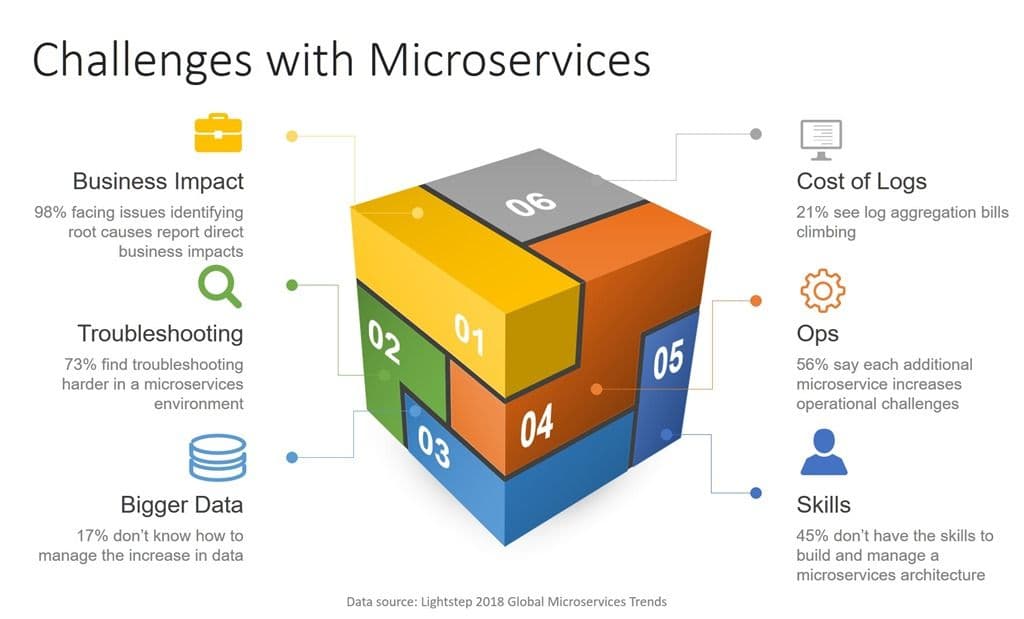Just a few short years ago microservices were a curiosity discussed by developers with a kind of giddy excitement at the possibilities and opportunities the fledgling app architecture presented.
Today, even us networky folks are talking about them because they’ve pretty much become – as the latest research from Lightstep declares – mainstream in the enterprise. Seriously. In our 2018 State of Application Delivery report, even network-related roles indicated they desired application services to be served up in containers. So it should not be a surprise to find that the aforementioned Lightstep survey found that not only do 91% of their respondents use or plan to use microservices, but 86% also expect them to be the default within five years.
That’s not to say that there aren’t challenges. In fact, 99% of respondents in Lightstep’s survey reported challenges when using microservices. From the responses, one could reasonably say that pretty much everything is more difficult (and sometimes expensive) with microservices.

The survey noted both business and operational challenges ranging from the cost of log aggregation rising (21%) to not knowing what to do with the increase in data (17%) to difficulties with troubleshooting problems (73%).
More troubling, however, was the finding that “98% of those that face issues identifying the root cause of issues in microservices environments report it has a direct business impact.”
This is one of the key challenges echoed elsewhere, usually using the terms “visibility” or “observability”, depending on whether you’re on the network side of the fence or hanging with DevOps.
Both essentially describe the same capabilities – being able to see what’s going on as messages are traversing the network from client to service and back. Inside the container environment, this is particularly challenging because of the scope and scale of the services involved.
With a traditional three-tier web app you have three sets of logs and three systems you need to track. With a microservices architecture – likely fronted by an API that’s potentially used by both web and mobile clients – you may have tens or hundreds of different services you need to keep track of.
The scaling model is still the same – we’re horizontally scaling (out) with clones – but the magnitude within a container environment is significantly larger. It’s like playing whack-a-mole with a hundred holes instead of ten. Figuring out the path any given transaction took is going to be challenging, to say the least. Especially when the path may have disappeared. After all, the premise of most container environments is to fail fast and replace instances rather than wait for manual intervention.
There are a couple of ways to address this challenge. First and foremost is instrumentation that assists in tracing and troubleshooting. This approach is not new but it is made more challenging by the volatile nature of container environments. Still, insertion of tracing elements (such as custom HTTP headers with unique identifiers) can be a huge boon to ops when trying to track down errors or performance problems. While typically not a capability of native container scaling options, it is one that service meshes are tackling as part of their offerings.
Second is the ability to quarantine ailing microservices to allow ops and dev to examine the system in the state that caused it to fail. Quarantine basically removes the ailing container from the active environment so calls are no longer sent to it, but keeps it alive for analysis and inspection.
There is no magic wand, but being able to track and quarantine containers in microservices-based deployments can go along way toward lowering the mean time to resolution (MTTR) and reducing the impact on the business.
About the Author

Related Blog Posts

AppViewX + F5: Automating and orchestrating app delivery
As an F5 ADSP Select partner, AppViewX works with F5 to deliver a centralized orchestration solution to manage app services across distributed environments.

Build a quantum-safe backbone for AI with F5 and NetApp
By deploying F5 and NetApp solutions, enterprises can meet the demands of AI workloads, while preparing for a quantum future.

F5 ADSP Partner Program streamlines adoption of F5 platform
The new F5 ADSP Partner Program creates a dynamic ecosystem that drives growth and success for our partners and customers.
F5 NGINX Gateway Fabric is a certified solution for Red Hat OpenShift
F5 collaborates with Red Hat to deliver a solution that combines the high-performance app delivery of F5 NGINX with Red Hat OpenShift’s enterprise Kubernetes capabilities.
F5 Silverline Mitigates Record-Breaking DDoS Attacks
Malicious attacks are increasing in scale and complexity, threatening to overwhelm and breach the internal resources of businesses globally. Often, these attacks combine high-volume traffic with stealthy, low-and-slow, application-targeted attack techniques, powered by either automated botnets or human-driven tools.
Phishing Attacks Soar 220% During COVID-19 Peak as Cybercriminal Opportunism Intensifies
David Warburton, author of the F5 Labs 2020 Phishing and Fraud Report, describes how fraudsters are adapting to the pandemic and maps out the trends ahead in this video, with summary comments.
